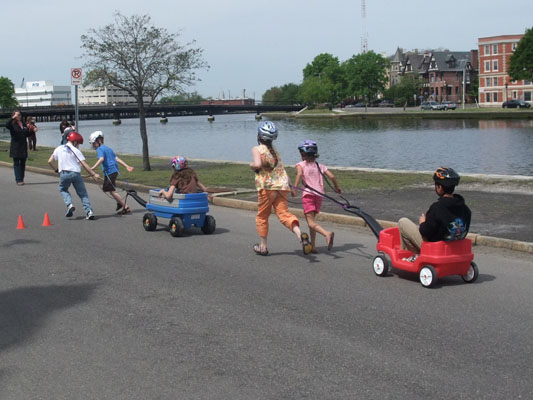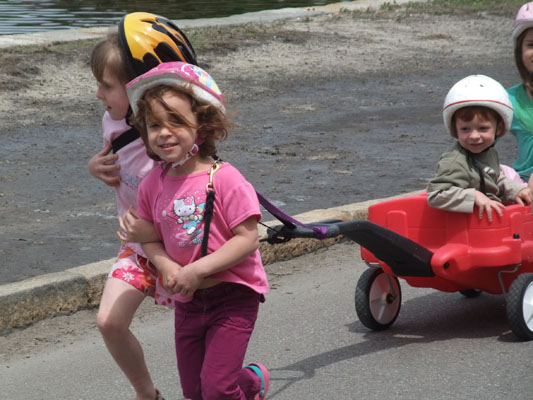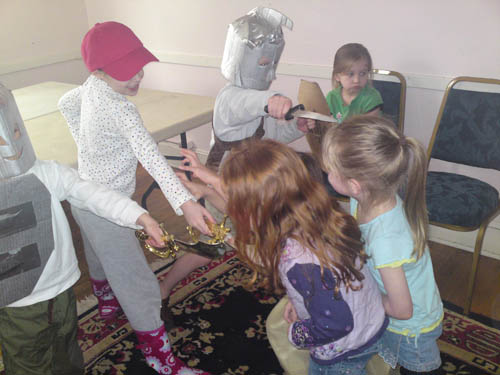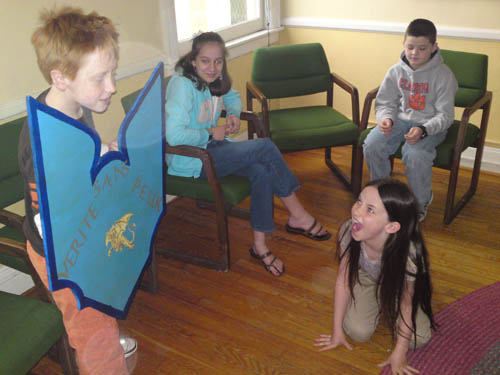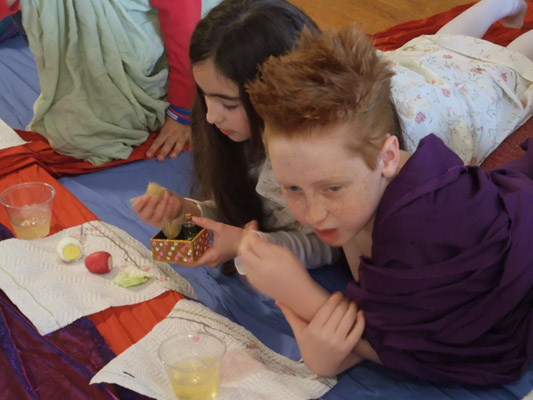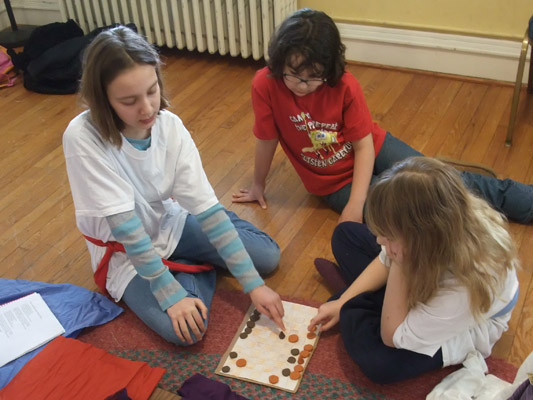
This post relates to my literature class for children at
Homeschool Out of the Box co-op in Norfolk, VA. This semester we are reading The Aeneid, using Penelope Lively's book
In Search of a Homeland, and other supplemental materials. For other lessons, please click the Aeneid tag at the bottom of this post.
Quiz: We took our quiz on the Roman clothing fast facts and remembered that different colored togas were worn in different situations: purple for emperors, white for those running for political office, and black for mourning. The challenge for this week is to look out for togas or toga-like garments being worn around town. Hint: Those people in Statue of Liberty costumes dancing around outside all the tax preparation offices might be one example.
Songs: We sang our songs, still working on memorizing the first eight lines of the Shakespeare soliloquy and the first four lines of the Virgil invocation. The children's favorite song is definitely "Let's Get the Heck Out of Troy," no doubt because of the mildly transgressive "heck" which I would apologize for if I didn't so intensely enjoy seeing them get a big bang out of singing it.
Memory Work: We were very excited to hear our first successful recitation of the Mark Antony's speech at Julius Caesar's funeral by William Shakespeare! Richard F. is the first Roman to possess two citizenship coins and got himself a set of knucklebones for his trouble. Congratulations and well done!!! Amazing work!
Fast Facts: This week we are learning about Roman games and toys. We learned the rules for Tali (the Latin name for Knucklebones), Odds and Evens, and introduced Latrunculi. We talked about how a lot of the simple toys that children use today and a lot of the familiar games we play were already around in Ancient Rome. It's important for them to recognize, in the midst of learning about all the differences in Roman culture, that there are many similarities.
Knucklebones: Tali is an ancient game played with four four-sided dice. You roll all the dice, calculate your score, and then the other guy rolls, for a predetermined number of rounds. Scores are not cummulative: whoever wins each round gets a point, and you play to a certain number of points. Click on this page to read all about
knucklebones. Here is a picture of a real set of knucklebones, made from the actual bones of a sheep or goat:

The little one in the picture above is actually made from bronze, to minic the shape of the real bone. Here is a picture of a set of knucklebones that I made:

You can make knucklebones by making a little rectangular box out of Sculpey, then scratching a number into each side. The small ends should be a little rounded to ensure the die doesn't end with a small end up. The numbers on the dice are 6, 4, 3, and 1 with opposite sides adding up to 7. I made enough sets that each pair of kids could have a set to play with. One package of Sculpey makes two sets.
Scoring Tali is complicated, and there are lots of different ways to do it. We learned a method of scoring that requires the kids to add up the values of the dice in their heads, which I think is good practice, and also involves some of the "special" rolls, like the Venus (6, 4, 3, 1) the Vulture (all dice the same) and the Dogs (all dice 1).
(6,4,3,1) :Venus -- all four tali with different sides.
(6,x,x,x) : Senio -- a single six and anything
(6,6,6,6) : Vultures -- all four tali the same
(4,4,4,4) : Vultures -- all four tali the same
(3,3,3,3) : Vultures -- all four tali the same
(6,6,6,4) : Total = 22
(6,6,6,3) : Total = 21
(6,6,4,4) : Total = 20
(6,6,6,1) : Total = 19 (high)
(6,6,4,3) : Total = 19
(6,6,3,3) : Total = 18
(6,6,4,1) : Total = 17
(6,6,3,1) : Total = 16
(4,4,4,3) : Total = 15
(6,6,1,1) : Total = 14 (high)
(4,4,3,3) : Total = 14
(4,4,4,1) : Total = 13
(4,4,3,1) : Total = 12
(4,3,3,1) : Total = 11
(4,4,1,1) : Total = 10 (high)
(3,3,3,1) : Total = 10
(4,3,1,1) : Total = 9
(3,3,1,1) : Total = 8
(4,1,1,1) : Total = 7
(3,1,1,1) : Total = 6
(1,1,1,1) : Dogs -- lowest of the Vultures
Here are some pictures of the kids playing Tali:
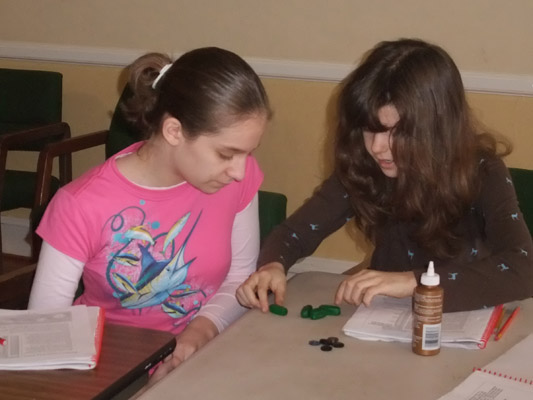

Odds and Evens: This is a very simple game that relies more on instinct than skill. To play, you need several small objects: buttons, coins, stones, etc. They should be small enough that the players can hide them in their hands. We used little buttons. The game is played between two people, a holder and a guesser. The holder puts a number of the objects in his hand and holds it out. The guesser tries to guess whether the number of objects is odd or even. If the guesser is right, he gets a point. If the guesser is wrong, the holder gets a point. Very easy, and yet when you start playing it, very complicated psychologically! But this one was really fun -- we had some kids that were really great at intuiting what their opponent would do with those buttons!
The educational value of Odds and Evens was mostly for the enrichment class -- learning which numbers were odd and which were even. The older kids could pretty much do that already. All the kids learned to make a score-keeping chart and keep tick marks to tally a score. It is also very important to practice your "I AM INSCRUTABLE" face and also your "I AM READING YOUR MIND" face while playing Odds and Evens.
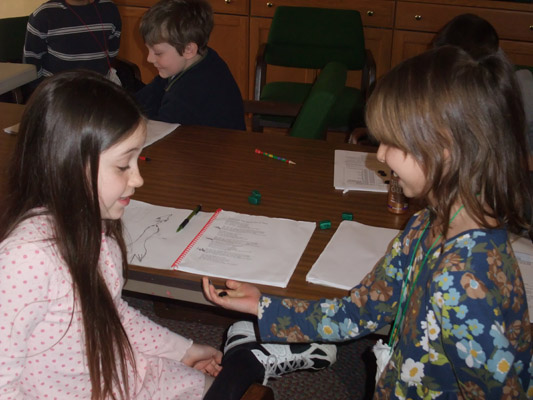

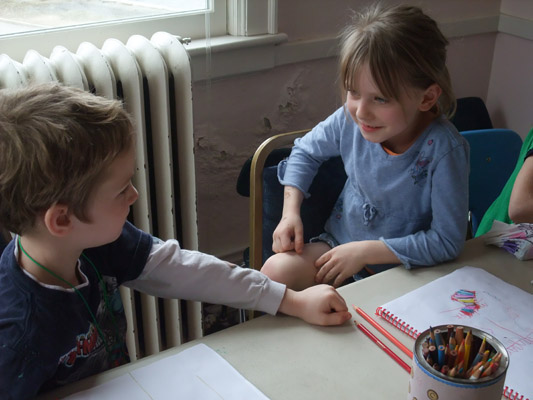
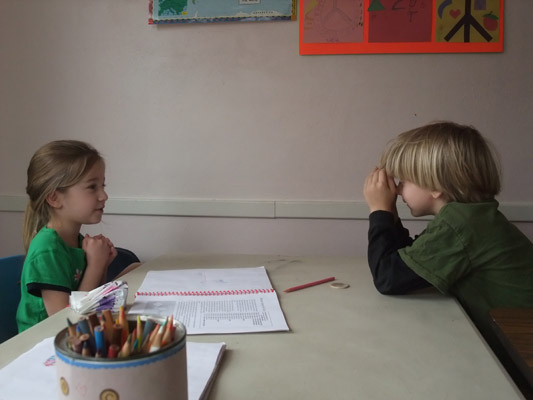
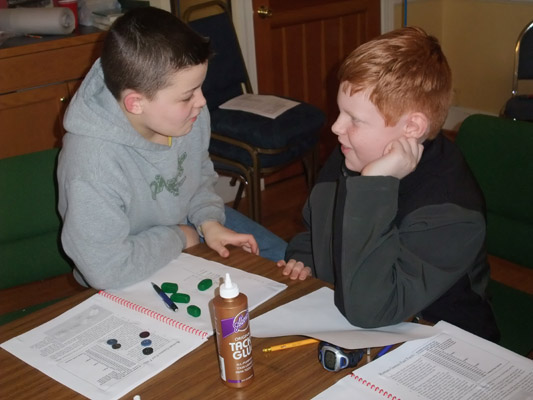
For more pictures, see our Flickr set.
Latrunculi: I gave the children an optional project to earn an additional citizenship coin. They can make a Latrunculi board and demonstrate that they know how to play. This is not an assignment! Moms, do not slay yourself over this one. If the kid is on fire to research it and make it, great. If not, no harm. Here is a link to get you started on the wonders of Latrunculi.
Next week is our Roman dinner party. Here is a little info about that:
CLOTHING:Please dress up in whatever way you like! Want to be a gladiator? An emperor? Afine lady? A humble slave? A senator? Do it. Gender roles to not have to limit you. Historical accuracy is not necessary but it would be great if the kids knew about their outfits to explain them to the class. Remember that among the ladies, elaborate up-do hairstyles and flamboyant jewelry items were popular!
MUSIC:We are going to be listening to the music of Synaulia, an Italian ensemble that replicates the music of Ancient Rome with authentic instrumentation. Here is a little sample:
http://www.youtube.com/watch?v=f0IpxYUi2Dk
http://www.youtube.com/watch?v=dnDjFXRZLVo
FOOD:Our meal will be eaten as we recline around low tables. We will be using our fingers to eat from communal plates. There will be three courses: an appetizer course of eggs and radishes, a main course of meat, olives, and cabbage, and a dessert course of fruit and honey.We will be drinking "wine." The Romans watered down their wine and added honey. Rich Romans who could afford the luxury kept ice in deep pits. We will be drinking white grape juice over crushed ice.
ENTERTAINMENT:Romans entertained at dinner parties by reciting poetry, singing, and dancing.Fortunately we can do all these for ourselves! If your child is ready to recite any part of (or all of) any of the poems or songs, they will get a chance toperform at the dinner party, as we all digest.We will also be playing Evens and Odds, Knucklebones (Tali), and Latrunculi.
RITUAL: As host of the party, I will start off the meal with a toast. We will also pause between "prima mensa" and "secunda mensa" (dinner and dessert) to observe amoment of silence and make an offering to our household gods.
VOLUNTEERS: How can you help?
Prepare food: If you can help with any of the above items (like bringing a dozen peeled boiled eggs, or a dish of olives, or a plate of chopped cabbage orgrapes), please email me and let me know what you'd like to bring.
Come be a slave: We will need a couple of slaves during each class, to serve thefood, crush the ice, fix loose togas, press play and pause on our musicians, help with Knucklebones, and obey our every whim. Slaves do not need to wear costumes, but they can! Slaves can also bring their cameras.
Lend something: If you have an earthenware or pottery dish that looks oldy-timey-ancienty-romany, I would love to borrow it for serving. If you have a statuette of some kind that looks oldy-timey-ancienty-romany, I would love to borrow it to join our collection of household gods to receive our sacrifice.
If you are interested in participating in one of these three ways, please email me and let me know specifically what you would like to do. This is going to be awesome!
NOTE: Students must possess a citizenship coin to participate in the Roman dinner party! No invitees unless they are the children of slaves who are slaving away at the party.
Assignments: Carry on with the book. Carry on with the memory work. Consider making a Latrunculi board. And get your costume on for next week's party!
 This post relates to my literature class for children at Homeschool Out of the Box co-op in Norfolk, VA. This semester we are reading The Aeneid, using Penelope Lively's book In Search of a Homeland, and other supplemental materials. For other lessons, please click the Aeneid tag at the bottom of this post.
This post relates to my literature class for children at Homeschool Out of the Box co-op in Norfolk, VA. This semester we are reading The Aeneid, using Penelope Lively's book In Search of a Homeland, and other supplemental materials. For other lessons, please click the Aeneid tag at the bottom of this post.





